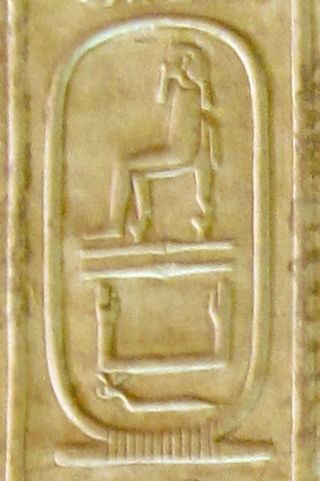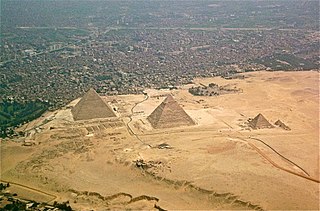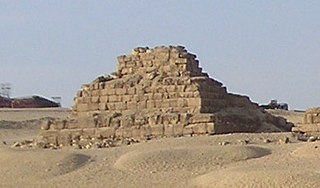
The Great Pyramid of Giza is the largest Egyptian pyramid and the tomb of Fourth Dynasty pharaoh Khufu. Built in the early 26th century BC during a period of around 27 years, the pyramid is the oldest of the Seven Wonders of the Ancient World, and the only one to remain largely intact. It is the most famous monument of the Giza pyramid complex, in the Pyramid Fields of the Memphis and its Necropolis UNESCO World Heritage Site, in Giza, Egypt. It is at the most Northern end of the line of the 3 Pyramids of Giza.

Giza is the third-largest city in Egypt by area after Alexandria and Cairo; and fourth-largest city in Africa by population after Kinshasa, Lagos and Cairo. It is the capital of Giza Governorate with a total population of 4,872,448 in the 2017 census. It is located on the west bank of the Nileopposite central Cairo, and is a part of the Greater Cairo metropolis. Giza lies less than 30 km (18.64 mi) north of Memphis, which was the capital city of the unified Egyptian state during the reign of pharaoh Narmer, roughly 3100 BC.

The Egyptian pyramids are ancient masonry structures located in Egypt. Sources cite at least 118 identified "Egyptian" pyramids. Approximately 80 pyramids were built within the Kingdom of Kush, now located in the modern country of Sudan. Of those located in modern Egypt, most were built as tombs for the country's pharaohs and their consorts during the Old and Middle Kingdom periods.

Shepseskaf was a pharaoh of ancient Egypt, the sixth and probably last ruler of the fourth dynasty during the Old Kingdom period. He reigned most probably for four but possibly up to seven years in the late 26th to mid-25th century BC.

The pyramid of Menkaure is the smallest of the three main pyramids of the Giza pyramid complex, located on the Giza Plateau in the southwestern outskirts of Cairo, Egypt. It is thought to have been built to serve as the tomb of the Fourth Dynasty Egyptian Pharaoh Menkaure.

The Giza pyramid complex in Egypt is home to the Great Pyramid, the Pyramid of Khafre, and the Pyramid of Menkaure, along with their associated pyramid complexes and the Great Sphinx. All were built during the Fourth Dynasty of the Old Kingdom of ancient Egypt, between 2500 and 2600 BC. The site also includes several temples and cemeteries and the remains of a workers' village.

Mark Lehner is an American archaeologist with more than 30 years of experience excavating in Egypt. He was born in North Dakota in 1950. His approach, as director of Ancient Egypt Research Associates (AERA), is to conduct interdisciplinary archaeological investigation. Every excavated object is examined by specialists to create an overall picture of an archaeological site—from the buildings down to the pollen spores. His international team currently runs the Giza Plateau Mapping Project, excavating and mapping the ancient city of the builders of the Giza pyramid complex, which dates to the fourth dynasty of Egypt. He discovered that Pyramid G1-a, one of the subsidiary pyramids of the Great Pyramid, belonged to Hetepheres I; it was originally thought to belong to Queen Meritites I.

Abusir is the name given to an ancient Egyptian archaeological pyramid complex comprising the ruins of 14 pyramids dating to the Old Kingdom period, and is part of the Pyramid Fields of the Memphis and its Necropolis UNESCO World Heritage Site.

The Giza Plateau is a limestone plateau in Giza, Egypt, the site of the Fourth Dynasty Giza pyramid complex, which includes the pyramids of Khufu, Khafre and Menkaure, the Great Sphinx, several cemeteries, a workers' village and an industrial complex. It forms the northernmost part of the 16,000 ha Pyramid Fields in the Western Desert edge of the Nile Valley that are part of the UNESCO World Heritage Site, Memphis and its Necropolis.

George Andrew Reisner Jr. was an American archaeologist of Ancient Egypt, Nubia and Palestine.

The Khufu ship is an intact full-size solar barque from ancient Egypt. It was sealed into a pit at the foot of the Great Pyramid of pharaoh Khufu around 2500 BC, during the Fourth Dynasty of the ancient Egyptian Old Kingdom. Like other buried Ancient Egyptian ships, it was apparently part of the extensive grave goods intended for use in the afterlife. The Khufu ship is one of the oldest, largest and best-preserved vessels from antiquity. It is 43.4 metres (142 ft) long and 5.9 metres (19 ft) wide, and has been identified as the world's oldest intact ship, and described as "a masterpiece of woodcraft" that could sail today if put into a lake or a river.
Meritites I was an ancient Egyptian queen of the 4th Dynasty. Her name means "Beloved of her Father". Several of her titles are known from a stela found at Giza. She was buried in the middle Queen’s Pyramid in Giza.

The East Field is located to the east of the Great Pyramid of Giza and contains cemetery G 7000. This cemetery was a burial place for some of the family members of Khufu. The cemetery also includes mastabas from tenants and priests of the pyramids dated to the 5th and 6th Dynasty.

Cemetery GIS is a necropolis in the Giza Plateau. It derives its name from its proximity to pyramid G I (Khufu). The tombs are located on the south side of that pyramid and hence the name G I South Cemetery. Reisner thought the cemetery a continuation of the G7000 cemetery which is part of the Giza East Field. The construction postdates that of mastaba G 7070 of Sneferukhaf. Junker dated the cemetery to the reign of Menkaure based on the presence of granite powder thought to derive from the dressing of the second pyramid at Giza. Reisner allows for a possible construction date dating to the reign of Khafre.

G1-a is one of the subsidiary pyramids of the Giza East Field of the Giza Necropolis, located immediately to the eastern side of the Great Pyramid of Giza. It was built during the Fourth Dynasty of Egypt. The tomb is the northernmost of the three pyramids of the queens and has a base of 49.5 metres (162 ft) wide and originally a height of 30.25 metres (99.2 ft); the pyramid has lost two-thirds of its original height. In the west wall of the burial chamber a small niche was dug in which were found fragments of basalt. It is also known as the Pyramid of Hetepheres I as discovered by Mark Lehner; it was originally thought to belong to Queen Meritites I.

G1-c is one of the subsidiary pyramids of the Giza East Field of the Giza Necropolis immediately to the eastern side of the Great Pyramid of Giza, built during the Fourth Dynasty of Egypt. It is the southern of the three pyramids of the queens and is the one of Queen Henutsen. It is 46.25 metres wide and had a height of 29.60 metres. A niche, four inches deep was dug in the south wall of the burial chamber. Pyramid G1-c was originally not a part of Khufu's pyramid complex, as its southern side is aligned not with the side of the Great Pyramid, but with Khufukhaf I's mastaba tomb nearby. Pyramid G1-c was at some point thought to possibly be a satellite pyramid, because it did not come with a boat pit like pyramids G1-a and G1-b. It was later determined to be an unfinished pyramid however which was constructed in a hurry. Henutsen is thought to have been buried in the tomb. Dr. Rainer Stadelmann believes Khufukhaf is the same person as Khafra and the pyramid was built by him for his mother, but this identification is doubtful.

Pyramid G1-d is a satellite pyramid within the Khufu Pyramid complex on the Giza plateau.

G3-c is one of the three pyramid companions Pyramid of Menkaure. It is located on the south side of the Menkaure pyramid in the Giza Necropolis. It is the westernmost of the three pyramids of the queens.

G3-a is one of the three pyramid companions Pyramid of Menkaure. It is located on the south side of the Menkaure pyramid in the Giza Necropolis. It is the easternmost of the three pyramids of the queens. The pyramid was built during the Fourth Dynasty of Egypt, presumably for one of the wives of Menkaure. The American archaeologist George Andrew Reisner was "confident" that the structure housed Khamerernebty II, but this is far from certain.

G3-b is one of the three pyramid companions Pyramid of Menkaure. It is located on the south side of the Menkaure pyramid in the Giza Necropolis. It is the middle of the three pyramids of the queens, and in the structure the body of a woman was discovered. The American archaeologist George Andrew Reisner speculated that the queen buried in the pyramid may have been Menkaure's half-sister, Shepsetkau, the daughter of Meresankh III and Khafre.





















